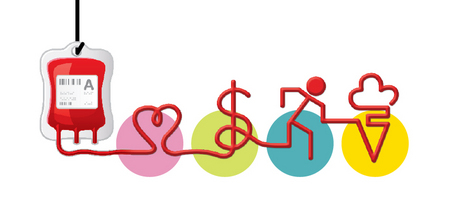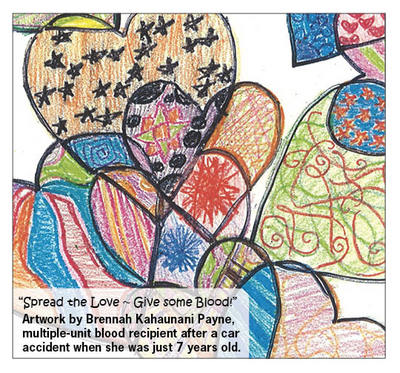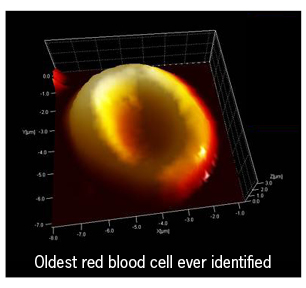October 24, 2012 at 9:34 am
Published by Stanford Blood Center

By Jennifer Boyer, Staff Writer, American Association of Blood Banks
Blood products and pop culture are an unlikely combination. Yet blood products have found their way into pop culture consciousness in recent years from celebrities publicly supporting blood-related causes to the vampire and zombie crazes. They are even impacting lifestyle choices such as diet, exercise and dating.
October 2, 2012 at 11:33 am
Published by Stanford Blood Center
By Billie Rubin, Hemoglobin's Catabolic Cousin, reporting from the labs of Stanford Blood Center
The term "buffy coat" might make you think of a shiny car wax, but in the world of blood banking, buffy coat refers to the white layer between red blood cells and plasma in a unit of whole blood after it has been spun down in a centrifuge. The buffy coat contains white blood cells, the soldiers of the immune system.
September 21, 2012 at 9:49 am
Published by Stanford Blood Center

By Billie Rubin, Hemoglobin's Catabolic Cousin, reporting from the labs of Stanford Blood Center
It looks like our O+, O-, A+, and A- RBCs are going out to our hospitals at blinding speeds these days. When many of these blood types are at or near the critical levels in our inventory, everyone's work here at SBC is cut out for them. Finding and scheduling donors, setting up mobile blood drives, drawing the blood, testing it in the lab and processing it for transfusion has our little hands working as fast as they can go.
September 14, 2012 at 2:09 pm
Published by Stanford Blood Center
By Billie Rubin, Hemoglobin's Catabolic Cousin, reporting from the labs of Stanford Blood Center
Cytomegalovirus (CMV) is a virus that 50 - 85% of adults have been exposed to at some point in their lives. It is passed by person-to-person contact with body fluids, and it is in the same family of viruses that cause chicken pox and mononucleosis. In healthy people, it rarely results in serious illness and can remain dormant in their bodies for the rest of their lives.
July 20, 2012 at 11:12 am
Published by Stanford Blood Center
By Billie Rubin, Hemoglobin's Catabolic Cousin, reporting from the labs of Stanford Blood Center
A heroic red blood cell - courageous, selfless, hard-working, picking up billions of oxygen molecules in the alveoli and coursing through the heart and every corner of the body electric feeding hungry tissues
July 13, 2012 at 10:50 am
Published by Stanford Blood Center
By Billie Rubin, Hemoglobin's Catabolic Cousin, reporting from the labs of Stanford Blood Center
Red blood cell (RBC) antigens have to be good for something - nature doesn't make useless things for no reason. We have similar ABO antigens to some on bacteria, pollen, grains, etc., and these may be involved in stimulating the production of our natural anti-A and anti-B antigens.
June 20, 2012 at 11:32 am
Published by Stanford Blood Center
By Billie Rubin, Hemoglobin's Catabolic Cousin, reporting from the labs of Stanford Blood Center
It seems a rotavirus strain is using the sugar at the end of the type-A molecule as a doorway to the inside of cells. "A sugar molecule linked to type-A blood helps the rotavirus strain invade cells in the gastrointestinal tract," a study has shown. "The virus is the leading cause of severe dehydration and diarrhea in infants, and causes an estimated 500,000 deaths worldwide each year. Specific blood group molecules are already known to promote infection by the stomach bug Helicobacter pylori (H. pylori) and norovirus."
May 25, 2012 at 10:11 am
Published by Stanford Blood Center

By Billie Rubin, Hemoglobin's Catabolic Cousin, reporting from the labs of Stanford Blood Center
In 1991, a couple hiking through the Italian Alps noticed something curious buried in the ice. What was assumed to have been the body of a fallen hiker, probably from a few years back, turned out to be "a 20th century archaeological sensation". The remains were 5300 years old from a man who became known as Oetzi, a.k.a. The Iceman.
March 20, 2012 at 3:25 pm
Published by Stanford Blood Center
By Billie Rubin, Hemoglobin's Catabolic Cousin, reporting from the labs of Stanford Blood Center
Today is the first day of spring! Get ready to be wowed by flowers blooming, love blossoming, and newborn farm animals running around. Youth and spring make blood bankers think of reticulocytes, red blood cells that haven't fully matured (the teenagers of the red cell world).
March 15, 2012 at 1:28 pm
Published by Stanford Blood Center

By Billie Rubin, Hemoglobin's Catabolic Cousin, reporting from the labs of Stanford Blood Center
Phlebotomy was once a hair-raising occupation. The PBS series Red Gold: The Epic Story of Blood tells of a specialized medical practitioner that arose in the Middle Ages: the barber-surgeon. Not only could you get your hair cut at the barber shop, but the barbers performed some minor surgical procedures such as blood letting as well. They created their own guild, competed with doctors, and advertised their services with their unique barber's pole still in use today.




